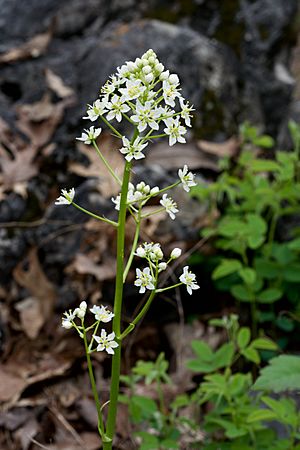Nuttall's death camas facts for kids
Quick facts for kids Nuttall's death camas |
|
|---|---|
 |
|
| Scientific classification | |
| Genus: |
Toxicoscordion
|
| Species: |
nuttallii
|
| Synonyms | |
|
|
Toxicoscordion nuttallii is a plant also known as Nuttall's death camas. It is a very poisonous plant. You might also hear it called death camas, poison camas, or poison sego.
This plant grows naturally in the south-central United States. You can find it in states like Arkansas, Oklahoma, Tennessee, Missouri, Louisiana, Mississippi, Kansas, and Texas.
Contents
What is Nuttall's Death Camas?
Toxicoscordion nuttallii grows from a bulb, much like an onion. It can grow quite tall, up to 75 centimeters (about 2.5 feet). This plant is known for its beautiful cream-colored flowers.
Plant Appearance and Flowers
Each plant can have many flowers, sometimes as many as 60! These flowers grow in clusters at the top of the stem. They are usually a pale, creamy color.
Why is it Called "Death Camas"?
The name "death camas" tells you something important. This plant is extremely poisonous. All parts of the plant, especially the bulb, contain toxic chemicals. Eating even a small amount can be very dangerous.
Safety Around Poisonous Plants
It is very important never to touch or eat wild plants unless an adult who knows about plants says it is safe. If you see a plant like Nuttall's death camas, admire it from a distance. Do not pick its flowers or dig up its bulbs.
Where Does This Plant Grow?
Nuttall's death camas prefers certain types of environments. It often grows in open, grassy areas. You might find it in prairies, meadows, or open woodlands.
Native Habitats in the US
Its native range covers a large part of the south-central United States. This means it has grown in these areas for a very long time. It is a natural part of the ecosystem there.
See also
 In Spanish: Toxicoscordion nuttallii para niños
In Spanish: Toxicoscordion nuttallii para niños

